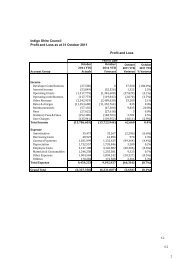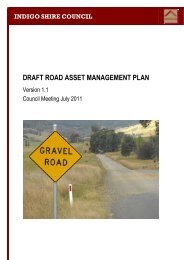Indigo Shire - renewable energy mapping - Indigo Shire Council
Indigo Shire - renewable energy mapping - Indigo Shire Council
Indigo Shire - renewable energy mapping - Indigo Shire Council
You also want an ePaper? Increase the reach of your titles
YUMPU automatically turns print PDFs into web optimized ePapers that Google loves.
Earth Systems<br />
Suggested Priorities for Decision Making<br />
Mapping and Brokering Local Energy Solutions in <strong>Indigo</strong> <strong>Shire</strong><br />
Reviewing the variety of resource potentials, generation costs and grid constraints presented in the<br />
preceding sections, it is possible to make some general observations on how a total generation output of<br />
13 MW e may be accomplished within the <strong>Indigo</strong> <strong>Shire</strong> region.<br />
<br />
<br />
<br />
<br />
<br />
<br />
<br />
There is little economy of scale benefit in going larger within the range of generation considered,<br />
other than for bio<strong>energy</strong> plant. Therefore, generation scale is likely to be dictated by network<br />
capacity (i.e. largest generator that can be connected without major network infrastructure costs).<br />
There are significant economic benefits in generation resulting in avoided retail power purchase.<br />
There are significant economic benefits in co-generation (possibly even tri-generation) at a given<br />
site.<br />
There may be additional incentives for installing site generation if it avoids the need for the<br />
network operator to undertake other infrastructure upgrades.<br />
Although the resource is marginal, the LCOE of wind means it is an attractive option..<br />
Where substantial cooling loads are present, there may be additional economic benefit in<br />
generating power from solar resources.<br />
If the majority of the biomass is to be purpose-grown (<strong>energy</strong> crops), the same basic generation<br />
equipment type can be used at all sites; and it may be advantageous to use a similar plant size<br />
and/or supplier to achieve capital cost reductions (multiple units purchase via consortium).<br />
Recommendations and Next Steps<br />
Overall recommendations from the Phase 1 Study are as follows.<br />
Solar<br />
Wind<br />
1. Maintain a watching brief on current technology costs, which are reducing rapidly.<br />
2. Consider any immediate opportunities for solar PV generation of less than 100 kW e , which in<br />
Victoria are currently eligible for a feed-in tariff (FIT) of 8 c/kWh (which for solar PV may not be<br />
commercially viable).<br />
3. Consider large-scale solar at specific sites where peak generation may be able to off-set large<br />
peaking cooling loads (large refrigeration loads such as refrigerated distribution centre, large<br />
winery or dairy).<br />
1. Consider whether local information can identify any specific locations that would yield a better<br />
resource (than currently mapped).<br />
2. The <strong>Shire</strong> should also consider engagement opportunities with other regions in which wind<br />
resources are more significant.<br />
3. Keep a watching brief on low-speed turbine developments.<br />
Geothermal<br />
1. Re-consider only if new geothermal data becomes available.<br />
Hydropower<br />
1. Consider limited possibilities for small-scale hydropower generation (

















